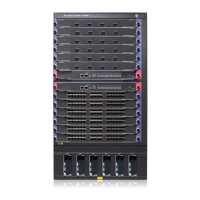212
Intf : Vlan-interface10 (up)
In-label : 100
Out-label : 200
Nexthop : 10.1.1.2
The output shows that a remote CCC connection has been established.
# Ping CE 2 from CE 1.
[CE1] ping 100.1.1.2
PING 100.1.1.2: 56 data bytes, press CTRL_C to break
Reply from 100.1.1.2: bytes=56 Sequence=1 ttl=255 time=180 ms
Reply from 100.1.1.2: bytes=56 Sequence=2 ttl=255 time=60 ms
Reply from 100.1.1.2: bytes=56 Sequence=3 ttl=255 time=10 ms
Reply from 100.1.1.2: bytes=56 Sequence=4 ttl=255 time=70 ms
Reply from 100.1.1.2: bytes=56 Sequence=5 ttl=255 time=60 ms
--- 100.1.1.2 ping statistics ---
5 packet(s) transmitted
5 packet(s) received
0.00% packet loss
round-trip min/avg/max = 10/76/180 ms
The output shows that CE 1 and CE 2 can ping each other.
Configuring SVC MPLS L2VPN
Network requirements
CEs are connected to PEs through VLAN interfaces.
Establish an SVC MPLS L2VPN between CE 1 and CE 2.
Figure 9 Network diagram
Device Interface IP address
Device
Interface
IP address
CE 1 Vlan-int10 100.1.1.1/24 CE 2 Vlan-int10 100.1.1.2/24
PE 1 Loop0 192.2.2.2/32
P
Loop0
192.4.4.4/32
Vlan-int20 10.1.1.1/24
Vlan-int30 10.2.2.2/24
PE 2 Loop0 192.3.3.3/32 Vlan-int20 10.1.1.2/24
Vlan-int30 10.2.2.1/24
Configuration considerations
1. Configure basic MPLS settings on the PEs and P device.
CE 1
CE 2
SVC
PE 1 PE 2P
Vlan-int20
Vlan-int20
Vlan-int30
Vlan-int30
Vlan-int10
Vlan-int10
Vlan-int10
Vlan-int10
Loop0 Loop0 Loop0

